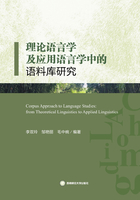
2. Literature review
1)The static verbs
In accordance to its definition excerpted from Oxford English Dictionary, static verbs indicate the existence of a state or condition. Quite a few linguists defined the term“static verbs”in various ways and tried to explain and find their properties. Generally speaking, there are three common interpretations for static verbs which are widely accepted.
Firstly, state is a kind of stable and homogeneous condition without internal structure which lacks the beginning and ending, and static verbs are characterized by unchangeableness(Smith, 1983). This interpretation also has been echoed by many traditional linguists. Secondly, Jeffrey (1976)argues that the dynamic verbs are obligatorily agentive whose subject refers to an animate object which is regarded as the willful source or agent of the activity described in the sentence and static verbs are involuntary whose subject could be passive or unconscious to accept the influence of the activity. The last interpretation is first proposed by Zhang. He points out the fact that static verbs are goal-attainment verbs indicating actions could achieve a specific goal, which illustrates why all static verbs are transitive verbs(Zhang,1990).
2)The progressive aspect
In general, the progressive aspect expresses the dynamic quality of actions which are in progress and describes an event that takes place in the course of a limited time period (Quirk, Leech & Svartvik,1985). Leech and Quirk (1971)pointed out three properties for progressive aspect, namely, duration, limited duration(or temporariness)and not necessary incompletion, while Flora (2012)had been in favor of time factors and suggested that the aspect of the progressive should have these three attributes:specifically limited duration, not necessary incompletion and time of reference within the time of situation. A conclusion could be drawn from the views described above that the duration and incompletion of the progressive aspect gained the acceptance. What's more, researchers should take note of the fact that their findings or opinions derive from the concept of dynamic process, which is the essence of progressive aspect (Bland,1988). Meanwhile, the progressive form was just a kind of grammatical form which made a distinction between the dynamic and static scene and described unfinished or developing events or actions, reminding researchers of the difference between progressive tense and progressive aspect (Richards,1985).
3)The static verbs used in the progressive verbs
Nevertheless, most scholars consider English static verbs should be not supposed to be used in the progressive aspect for static verbs, which is confirmed by the fact that the semantic essence of static verbs is to show the state of stabilization and homogeneity, just to name only a few.
Firstly, static verbs indicates the duration of the state or condition. So it is verbose and redundant to combine the static verbs with the aspect of the progressive which also contains the feature of duration in sentences(Palmer,1974).
Secondly, static verbs could not be used in the progressive aspect for they absented themselves form the dynamic state (Lyons,1997).
Thirdly, static verbs show the continuity of the action or the condition and its internal scene marked by no starting and no ending(the property of time reference). Provided that the static verbs are used in the progressive aspect with the property of temporariness, the semantic meaning of static verbs may be shifted under the aspectual coercion of the progressive aspect (Jose, 1994).
At the same time, some scholars called their questions for these explanations. Liang and Liu (2002)held the view that static verbs showed the process of the action that was static straight line not having dynamic changes, which might not be obvious to notice the motion of the static verbs. While dynamic verbs describe the actions that keep changing and making progress or a period of time full of twists and turns, which brought much more notice for observers. Besides, the meanings of static verbs were changed to show the dynamic nature of the process or bring out the hint of temporality if using the static verbs in the progressive aspect(Granath&Wherrity,2014).
In summary, there are various opinions for this issue whether the static verbs could be used in the progressive aspect or not. Some scholars investigated this phenomenon and gave their own fresh ideas. For instance, Li(2015)concluded both the reason and the interpretation of the sentences were results of the interaction between verbs and the English progressive construction from the aspect of aspectual coercion. Furthermore, Li(2011)in his paper assumed the key to understanding the phenomenon of English static verbs in the progressive form was to coordinate such verbs and other related components in a sentence, which would be of much significance to the teaching and the learning of English static verbs in the progressive form. Huddleston and Pullum (2002)also suggested that the meaning of the static verbs used in the progressive aspect would be reshaped or converted into the meaning belonging to another category which was different from the meaning of static verbs used in the past or the present aspect for the reason that the speaker wanted to indicate the dynamic nature and instantaneity of the event.